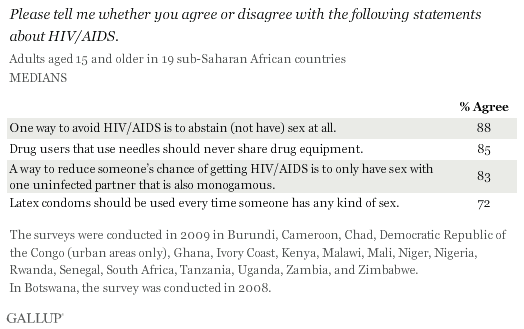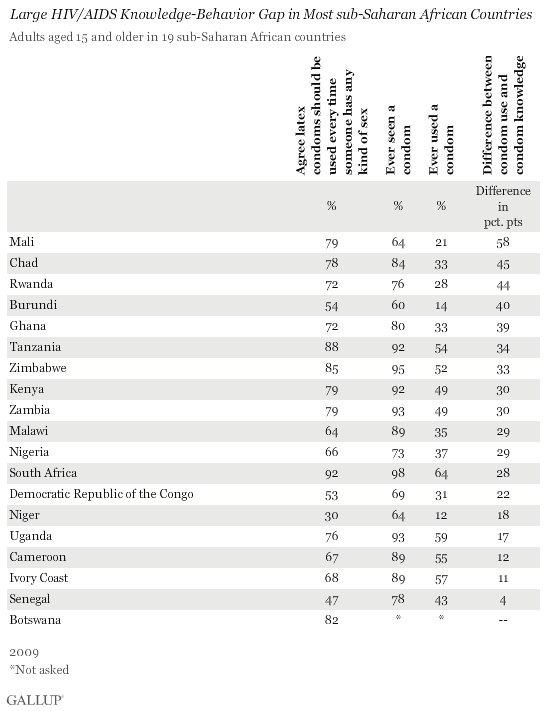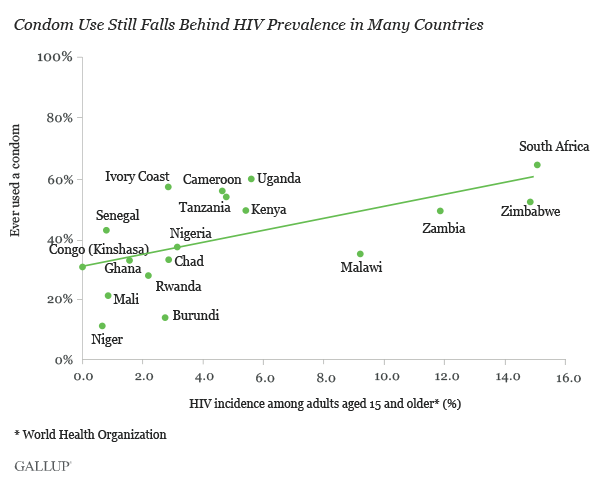WASHINGTON, D.C. -- Gallup surveys in 19 sub-Saharan African countries -- where almost two-thirds of the world's HIV-infected population lives today -- show majorities of adults know how to prevent the spread of the virus. Medians of more than 8 in 10 agree that abstinence and that monogamy with an uninfected partner reduce one's chance of getting HIV/AIDS and that drug users should not share needles. In addition, while a median of more than 7 in 10 agree that people should use condoms every time they have any kind of sex, they are less likely to agree with this statement than the other prevention measures tested in the poll.

These findings -- based on Gallup surveys conducted in 2009 and 2008 -- underscore how important efforts to raise awareness about HIV and AIDS, such as World AIDS Day on Thursday, are to combating the spread of the virus and disease in the region. According to a recent UNAIDS report, the number of new infections in sub-Saharan Africa decreased about 26% between the peak of the epidemic in 1997 and 2010 partly because of better access to antiretroviral drugs. The UNAIDS report also cites changes in behavior, including reducing the number of sexual partners, increasing condom use, and waiting longer to become sexually active, as spurring the decline.
Many Agree People Should Use Condoms, but Fewer Report Using Them
A median of 72% in the countries surveyed agree people should use latex condoms every time they have sex. But agreement ranges from 92% in South Africa to 30% in Niger. In general, knowledge about different ways to prevent HIV transmission, including condom use, is most widespread in countries where HIV infections are highest such as in Botswana and South Africa.
However, reported condom use is far lower. A median of 40% say they have ever used one, ranging from 64% in South Africa to 12% in Niger. In most countries surveyed, the gap between agreement that people should use condoms and reported use is at least 15 percentage points.
The difference between acknowledgement that condoms decrease the risk of HIV transmission and reported condom use is narrowest in Senegal. Starting in the mid-1980s at the onset of the HIV/AIDS epidemic, Senegal implemented a multipronged strategy that involved community organizations and other local stakeholders, according to UNAIDS. The strategy also involved a change in public attitudes, including an increased use of condoms. Today, Senegal's HIV adult prevalence rate of less than 1% is one of the lowest in the region.

Condom Use and HIV Prevalence
While reported condom use is relatively high in some countries, such as South Africa (64%), it may not be enough to stave off new infections, especially in countries where HIV prevalence is also high. But even in countries where less than 5% of the adult population lives with the virus, the results show condom use ranges greatly, which suggests the need to continue safe-sex behavior campaigns to prevent a substantial increase of HIV/AIDS disease burden in those countries.

Implications
Considering that HIV/AIDS is an important regional issue in terms of its potential effect on life expectancy, overall health, and economics, the results reveal the large gap between what people say they know about preventing the spread of the virus and what they do. These results suggest substantial barriers in being able to convince people to engage in safe-sex behaviors. Perhaps access to reliable sources of condoms is one of the issues. While the findings do not shed light on the source of such barriers, initiatives that involve community and religious leaders as well as traditional healers may help narrow the gap between individuals' HIV/AIDS awareness and their actions.
Further, although the findings show that strong majorities of sub-Saharan Africans surveyed know how people can avoid the virus, prevention programs need to reach far more people, including vulnerable populations such as women. To capitalize on the recent news about lower rates of new infections, HIV/AIDS prevention programs stand to play an important role in Africans' ability to build healthy, productive, and economically vibrant communities across the continent.

For complete data sets or custom research from the more than 150 countries Gallup continually surveys, please contact SocialandEconomicAnalysis@gallup.com or call 202.715.3030.
Survey Methods
Results are based on face-to-face interviews with 1,000 adults, aged 15 and older, conducted in 2009 in Burundi, Cameroon, Chad, Democratic Republic of the Congo (urban areas only), Ghana, Ivory Coast, Kenya, Malawi, Mali, Niger, Nigeria, Rwanda, Senegal, South Africa, Tanzania, Uganda, Zambia, and Zimbabwe. In Botswana, the survey was conducted in 2008. For results based on the total sample of national adults, one can say with 95% confidence that the maximum margin of sampling error ranges from ±3.5 percentage points to ±4.8 percentage points. The margin of error reflects the influence of data weighting. In addition to sampling error, question wording and practical difficulties in conducting surveys can introduce error or bias into the findings of public opinion polls.
For more complete methodology and specific survey dates, please review Gallup's Country Data Set details.
